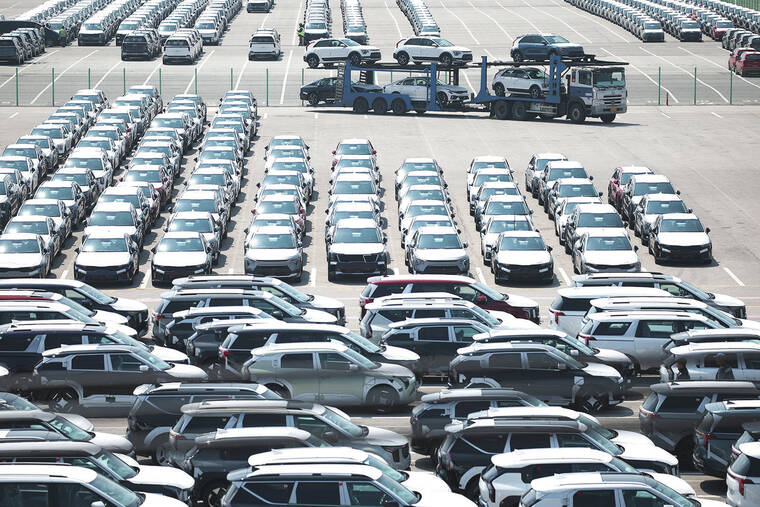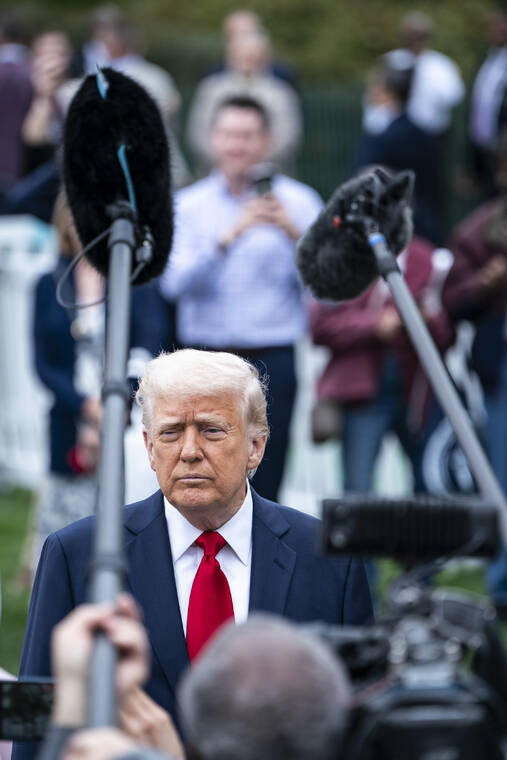Trump takes on improbable task in seeking trade deals across the globe


WASHINGTON — For a president who advertises himself as a paramount dealmaker, the next 11 weeks will be a pivotal test, as his advisers race to accomplish what no other administration has done before and reach dozens of individual trade deals with other governments.
President Donald Trump has promised big gains for American trade, and officials from Japan, South Korea, India and elsewhere have been pushing for agreements as they look to forestall punishing tariffs. But trade experts say the administration has set up a seemingly impossible task, given that traditional trade deals typically take months or years to negotiate.
ADVERTISING
Trump has tried to use tariffs as leverage to notch quick agreements, and his trade adviser, Peter Navarro, has promised “90 deals in 90 days.” But the levies are creating chaos and financial pain for many businesses, and they have not brought some of America’s largest trading partners, including China, to the table.
Some U.S. trade with China has ground to a halt after the countries imposed triple-digit tariffs on each others’ products, and a wave of bankruptcies, especially among small U.S. businesses that rely on Chinese imports, appears to be looming if the trade barriers are maintained.
Some Trump officials recognize that the situation with China is not sustainable and have been strategizing how to reduce the tariffs between the countries, two people familiar with the discussions said. Another person familiar with the discussions said administration officials were concerned about the hit to the stock market, which has experienced intense volatility and some of its worst trading days in years. The S&P 500 is down 10% since Trump’s Jan. 20 inauguration.
Speaking from the Oval Office on Wednesday, Trump said he wanted to make a deal with China. But he said what happens with his tariffs on China “depends on them.” He denied any concerns about what the tariffs are doing to small businesses, but said that the high tariff “basically means China isn’t doing any business with us.”
He also claimed the United States had spoken with 90 countries, all of which wanted to do deals. “Too many to fully deal with, but we’re going to be fair to them,” he said.
On Tuesday, Trump signaled that the 145% tariff he put on Chinese imports could drop. “It won’t be anywhere near that high,” he said. “It’ll come down substantially. But it won’t be zero.”
So far, officials from the United States and China do not appear to have engaged in substantive talks over the trade spat. Trump officials believe the Chinese economy is vulnerable, given its dependence on exports to the United States.
“President Trump has been clear: China needs to make a deal with the United States of America,” said Kush Desai, a White House spokesperson.
Scott Bessent, the Treasury secretary, on Wednesday dismissed speculation that the president was considering unilaterally lowering the tariffs that he had imposed on China before any negotiations with Xi Jinping, the Chinese leader. He emphasized that any moves to de-escalate trade tensions would need to be mutual.
“I don’t think either side believes that the current tariff levels are sustainable,” Bessent told reporters. “This is the equivalent of an embargo, and a break between the two countries on trade does not suit anyone’s interest.”
On Wednesday, Guo Jiakun, the spokesperson for the Chinese Foreign Ministry, reiterated that China would not be bullied by U.S. tariff threats.
“If the U.S. truly wants to resolve issues through dialogue and negotiation, it should stop threatening and coercing, and engage in dialogue with China on the basis of equality, respect and mutual benefit,” he said. “Talking about reaching an agreement with China while constantly pressuring China to the maximum is not the correct way to deal with China and will not work.”
Trump’s tariff threats have created urgency for other governments, motivating them to begin talks with the United States about removing tariffs and other trade barriers. On April 9, just hours after the president imposed stiff tariffs on nearly 60 countries, he paused them for 90 days, saying he would give governments a chance to negotiate trade deals instead.
This week, Karoline Leavitt, the White House press secretary, said that the Trump administration had received 18 proposals on paper and that the trade team was “meeting with 34 countries this week alone.”
“There is a lot of progress being made,” she said. “We are moving at Trump speed to ensure these deals are made on behalf of the American worker and the American people.”
Asked if the tariffs have actually worked, she responded, “Have some patience and you will see.”
But negotiating so many deals at the same time poses significant challenges. Many of Trump’s departments are still understaffed, with midlevel officials not yet confirmed. Torsten Slok, the chief economist at Apollo Global Management, an investment firm, wrote online that on average, trade deals signed by the United States had taken 18 months to negotiate and 45 months to implement.
“While markets wait for trade negotiations with 90 countries at the same time,” he wrote, “global trade is grinding to a standstill with problems similar to what we saw during COVID: growing supply chain challenges with potential shortages in U.S. stores within a few weeks, higher U.S. inflation and lower tourism to the U.S.”
Another hurdle, people familiar with the negotiations say, is that foreign governments say they do not know exactly what the Trump administration wants. And given Trump’s unpredictable demands, they are not sure that his deputies are empowered to close a deal with them.
Greta Peisch, a former trade official who is now a partner at law firm Wiley Rein, said the tight timeline raised questions about whether any deals concluded in the next few months would be “more tentative or aspirational” rather than actual trade agreements. She also said the economic benefits could be limited.
“When you look at some of these trade relationships, simply removing trade barriers likely won’t move the needle much in terms of changing trade flows in the near term,” she said.
South Korean finance and trade ministers were set to meet with Bessent and Jamieson Greer, the U.S. trade representative, on Thursday. Officials from Thailand, Japan, India and other countries were also scheduled to hold talks in Washington this week.
In a visit to New Delhi on Tuesday, Vice President JD Vance announced the outlines for a potential trade agreement with India, which would ramp up trade between the countries; reduce Indian barriers to U.S. exports; and fold in discussions of defense, energy and strategic technologies.
While the Trump administration has said some deals could be concluded quickly, initial meetings have suggested that talks could be more complicated, particularly with major trading partners like Japan.
The two nations have trade disputes extending back decades over industries like steel and auto parts. And some agreements under discussion — for example, a project that could see Japan, South Korea and Taiwan invest in a pipeline to export liquefied natural gas from Alaska — could take at least five years to come to fruition.
“Tokyo wants to preserve the alliance and keep peace with Trump, but without surrendering Japan’s interests,” Daniel Russel, the vice president of the Asia Society Policy Institute, wrote in a recent analysis. “The Japanese government is willing to increase investments in the U.S. and buy more American goods, but will resist being rushed and pressured into lopsided deals.”
South Korean officials also appear willing to discuss trade imbalances, as well as buying more natural gas and investing to revitalize the U.S. shipbuilding industry. But it is not clear the Korean government is in a position to aggressively negotiate a deal, given that the country’s president has been impeached and an election will not be held until June 3.
Speaking from Washington on Wednesday, Britain’s chancellor of the Exchequer, Rachel Reeves, also said there was no plan to rush into a trade deal with the United States.
Reeves, who was set to meet with Bessent, said she wanted to reduce trade barriers between Britain and other countries, but there were firm lines her government would not cross, like changing food or car safety standards.
With larger trading partners, like the European Union, discussions appear more difficult. European officials have expressed frustration about a lack of clear goals from the Trump administration.
“One would wish for more clarity on expectations,” Valdis Dombrovskis, the European commissioner responsible for the economy, said Wednesday at the Semafor World Economy Summit. He said that European officials had put forward “concrete proposals,” such as buying more liquefied natural gas and zero-for-zero tariffs on industrial goods but that the United States needed to provide more clarity on what it wanted.
© 2025 The New York Times Company






